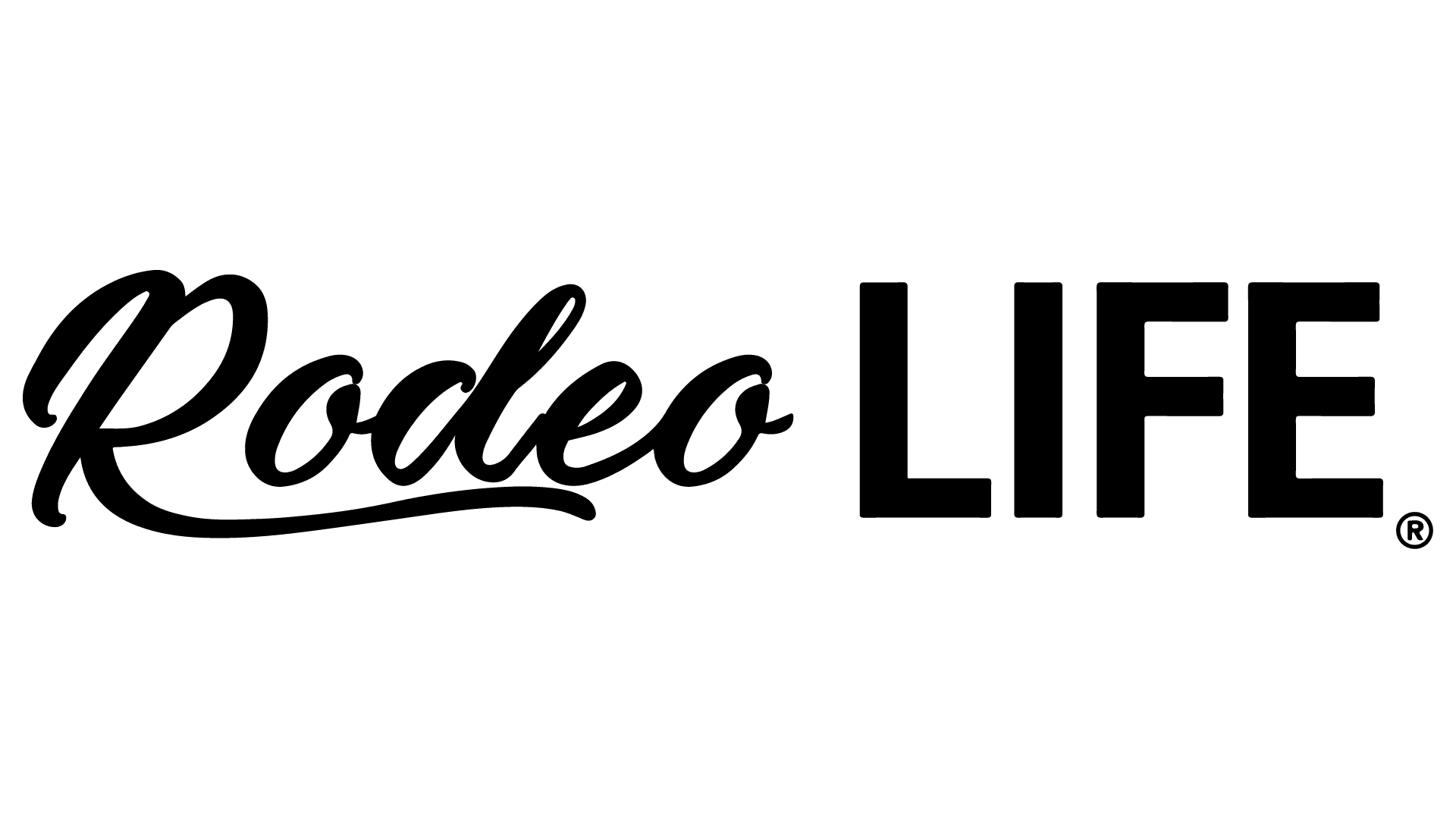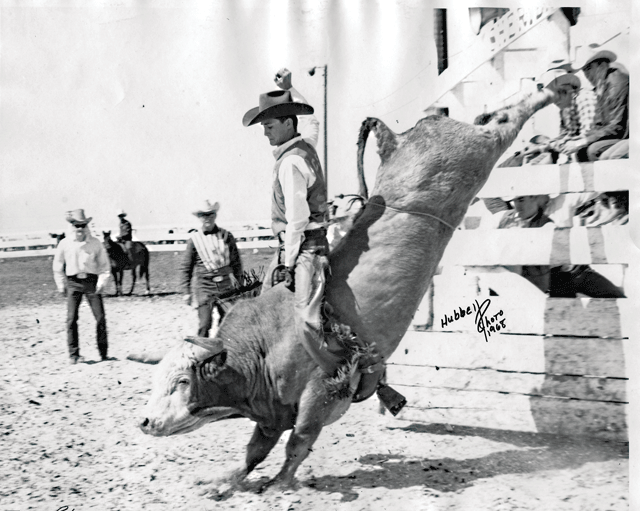courtesy of the family
For Jerome Robinson, being born in Ogallala, Nebraska (the self proclainmed “cowboy capital of Nebraska”), might have been an omen as he was destined to spend his entire life dreaming about, and then acting out the life of a cowboy… Specifically, a rodeo cowboy. A three-year-old Robinson announced he wanted to be a bull rider while attending the Denver Stock show with his grandmother. Later that year he rode a horse (led by his mounted father) in the county fair and rodeo parade. By age five he was riding calves on the family wheat farm in Brandon, Nebraska.
Riding calves evolved into riding steers and then cows in the farm’s corral that was converted into a make shift rodeo arena. These practice sessions along with breaking and training ponies and horses gave Robinson the confidence to enter little britches rodeos and later high school rodeos where he experimented in calf roping, bareback riding, and steer wrestling in addition to bull riding… He excelled at none of the rodeo events. When Robinson graduated from high school, he had not yet won an event at any of the rodeos entered and had placed only once.
Robinson enrolled in Colorado State University (CSU) in Fort Collins, Colorado with thoughts of studying veterinary medicene. While struggling with chemistry, Robinson discovered a rodeo arena in Boulder, Colorado that was scheduled to host weekly practice sessions every Sunday afternoon throughout the year, weather permitting. Robinson became a regular at Rex Walker’s Sombrero Ranch practice sessions where he cut a deal to serve as rodeo bull fighter in return for mounting all the stock he could, without paying the customary three dollar practice fee.
Robinson’s faithful practice habits didn’t render many results and his freshman year he was not selected to be on the csu rodeo team. Excluded from competing at any of the intercolligiate rodeos was his fate until team member injuries took their toll and Robinson was allowed to enter the last two rodeos of the year. Placing at both gave him a berth on the team and a trip to the National Intercollegiate Rodeo Association (NIRA) Finals in Yankton, South Dakota. The next two years of college, Robinson doubled down on the practice sessions along with attending World Champion Ronnie Rossen’s week long bull riding school where he got on thirty-three head of bulls at the seven day school. At one point, Robinson had practice sessions Tuesday and Thursday afteroons and Saturday and Sunday mornings in Fort Collins. Wednesday night and Saturday afternoon sessions took place in nearby Laramie, Wyoming and Sunday afternoon, it was Boulder again. Practice did not make perfect but it did make Robinson competitive on the intercolligiate level where he finished third and ninth nationally his junior and senior season, and the summers saw him being competitive at local PRCA rodeos while finishing fourth at Cheyenne Frontier Days in 1968.The 1970 PRCA rodeo year actually started the first rodeo after the 1969 San Franciso Cow Palace rodeo which ended in early November. All other 1969 rodeo winnings were credited to the 1970 championship standings. Robinson was attending his last few months of college, but to get a jump on the 1970 season, he would leave classes friday, driving overnight to scheduled PRCA rodeos in the midwest, competing on saturday or sunday and drive overnight to be back at school on Monday. St. Paul, Minnesota was the first rodeo of the 1970 season and Robinson drew up in the first performance on bull #1 and was the first bull rider to compete in that night’s performance. Robinson’s score held up for a first place finish. The next weekend was Bismark, North Dakota, where Robinson rode to another first place finish winning his first PRCA buckle and he won a second at the Chicago Stockyards rodeo over Thanksgiving weekend. The January 1st issue of the “Rodeo Sports News” had Robinson leading the bull riding standings. That would be the only issue in his sixteen years of competition (1967-82) that showed him leading the standings. Robinson would qualify for his first of eleven National Finals Rodeo (NFR) bull riding appearances, a PRCA record at the time. Robinson’s record would be broken by Donnie Gay, Wacey Cathy, Ted Nuce, and tied by Tuff Hedeman.
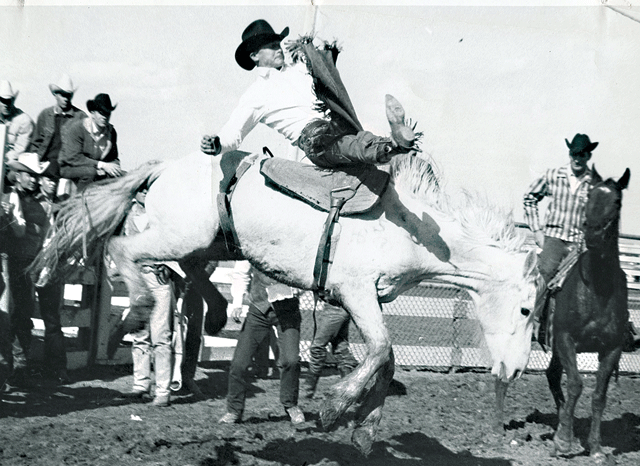
Jerome competing at the Fort Collins College Rodeo, 1967 – Clore Photo
Having qualified for his first NFR in 1970, Robinson decided to make some use of his degree in education and conduct a bull riding school. He recognized that at the seven day school he had attended, the majority of the learning was done in the first three days and the last four were just practice so he elected to cut the tuition in half and conduct a three-day riding clinic. Robinson’s clinics turned out some very accomplished riders. Wally Badgett from Ashland, Montana was a student at the first clinic and won the NIRA bull riding championship the next year and was an NFR qualifier four years later. Student’s from Robinson’s second and third clinic also won NIRA championships the year following their attendance. In addition to Badgett, several NFR qualifiers came from the ranks of Robinson’s clinic including Cody Lambert, Lonnie Wyatt, and Michael Gaffney (who, along with Owen Washburn, won PBR world titles).
After six consecutive NFR appearances, Robinson while serving his fourth year as the PRCA bull riding director became involved in the implementation of a centralized rodeo entry office, known then as rocom (rodeo communications) and today as procom (prorodeo communications) that utilized a computer programed to implement the rules and guidelines of the prca rulebook regarding entries and drawing of competitive positions and livestock. It also utilized a bank of toll- free telephone lines to accommodate the communications of the rodeo contestants, stock contractors, and committees. Procom essentially consolidated the in excess of five hundred prca rodeo entry offices across the united states into one, facilitating a more efficient and cost- effective method of producing PRCA rodeos. While attending to procom growing pains, Robinson found it difficult to focus on his riding and 1976 proved to be the only year in a twelve-year span, Robinson failed to qualify for a berth at the NFR.
Robinson left the 1981 NFR and elected to skip rodeos in Odessa, Texas and the Denver Stock Show for World Cup competition in Melbourne and Sydney Australia. Returning from Australia in time for the start of the Fort Worth Stock Show Rodeo, Robinson won a bull riding in Amarillo, Texas on his way to Fort Worth where he placed high in both of the first two go rounds and was leading the average going into the progessive third round. Prior to the his third round competition, Robinson competed in Scottsdale, Arizona, and was scheduled to fly from Scottsdale to Fort Worth the next morning when two bronc riders asked him to help them make the overnight drive and Robinson agreed. Robinson slept through the better part of the night and took over his driving shift at El Paso just after midnight Friday morning running into a Texas ice storm. Just past Big Spring, Texas, about three hours fom the Fort Worth destination, the storm seemed to subside, but a patch of ice sent the top-heavy van careening into the median, flipping onto its top, pinning Robinson’s right hand between the roof and the dashboard. An ambulance soon arrived and transported Robinson to the Big Spring hospital, leaving the bronc riders, who were uninjured, to settle the paperwork on the accident and find themselves a ride to Fort Worth where they were scheduled to ride that Friday night. Robinson was admitted to the hospital where a local surgeon amputated the end of two fingers and took skin from the front of his thigh and graphed it to the front of the two amputated fingers while suturing the third finger closed. All the time Robinson, being a left handed rider, was calculating his odds of competing on his third bull in Fort Worth. Calling the Fort Worth rodeo office, Robinson applied for and received a medical waiver allowing him to postpone his competition ride until Sunday afternoon. By Friday night, other residuals of the accident set in and Robinson was unable to lift his head off the hospital bed pillow. He all but abandoned any thoughts of Fort Worth competition. Amazingly, after a good nights rest, Robinson was much more mobile and began to think, “if I can improve as much in the next twenty-four hours as I have in the last eighteen, I think i could get on in Fort Worth”. By Saturday night, Robinson had made arrangements with a long-time-friend/traveling partner and Big Spring resident to catch a ride to Fort Worth for the Sunday afternoon third go round bull ride and hopefully the short-go finals Sunday night. Robinson arrived at the stock show arena in time to have Justin Sports Medicine’s team design and wrap a protective guard on the injured non-riding hand. Robinson scored a moderate score on a substandard bull in the afternoon performance and in the finals that night, Robinson posted another moderate score after the judges docked Robinson’s ride for being somewhat out of control on an excellent short go mount. Compounding Robinson’s lacluster performance was an unorthadox dismount that resulted in what Robinson thought was a dislocated knee but turned out to be a detached ligament. The injury required surgury and put Robinson on the medically disabled list for the next four months allowing him to return to competition on Memorial Day weekend. Robinson’s riding the remainder of 1982 was average at best and Robinson acknowledged that after riding competitive with the event’s premier riders for over a decade, riding just average wasn’t much fun. He announced his retirement that fall after making qualified rides on his last five bulls.
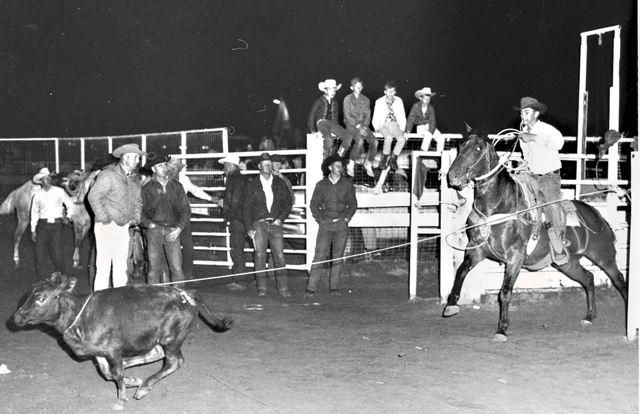
Jerome tie-down roping at a Nebraska High School rodeo, June 1965 in Harrison, Nebraksa – Ken Studio
During his four months of recovery, Robinson, who two years earlier had attended a three-day rodeo production seminar decided to try his hand at producing a rodeo. He convinced the CSU rodeo club to let him produce the “Skyline Stampede”, one of the oldest and longest running collegiate rodeos in the nation. The 1982 Skyline Stampede experienced a significant upgrade in entertainment value (complete with a sponsored “25 cent beer day”) and a modest increase in rodeo club profit. Robinson’s profits, though very modest monetarily, came in experience gained from producing a complete event from start to finish.
Another mini project Robinson involved himself in while convalescing consisted of Howard Harris, PRCA livestock contractor representative, Ken Stemler, PRCA Properties Inc. President, and Robinson making a sales presentation to Steve Gander, a notable indoor rodeo producer in the midwest to bring his brand of “World’s Toughest Rodeo” under the sanctioning umbrella of the PRCA. Gander elected to join the PRCA and at a point in the year that it was obvious Robinson was not going to make his twelfth NFR qualification, Robinson was extended an offer from Gander to be his PRCA livestock liaison and arena director. Warning Gander he would be hiring a neophyte in both job areas, Gander laughed, repeated the offer, and Robinson accepted.
The following three years, 1983-85, were filled with long days and short nights, with Gander and staff being responsible for Robinson receiving an education in rodeo production. In the late spring of 1985, Robinson was offered the position of production coordinator for a six event prca television series entitled “Winston Tour”. The rodeos were restricted to the top PRCA contestants selected to “outfits” with each “outfit” sponsored by a PRCA corporate partner. The best available livestock was used at each event with the televised performance being limited to the top six contestants in each event competing with two being eliminated, then four competing, eliminating two more, leaving the top two contestants in a head to head competition for the championship. In each televised performance, rodeo fans saw the top two contestants in each event compete three times on premium livestock in the two hour edited television show. The result was a rodeo fan’s dream.
After the 1985 debut year, the “Winston Tour” made appearances at several existing rodeos in 1986 and then yielded to political pressure from within the PRCA ranks, and the waning involvement of Winston cigarette advertising that became restricted by federal regulation. The “tour” was discontinued at the end of 1986, but the basic concept the Winston Tour was founded on… the top contestants competing on the best livestock, multiple times, in the same performance… Would surface again and play an important part in another chapter of Robinson’s rodeo career.
In 1986, Rex Walker of Sombrero Ranch practice arena, joined forces with Robinson to create Western Trails Rodeo (WTR) as a recognized PRCA livestock contracting firm. This made western trails rodeo an integrated company capable of producing rodeos from start to finish. While acquiring some venues from an acquisition of an existing company, 1987 proved to be a testing ground and was a springboard to 1988 and beyond when a couple of singing cowboys named Garth Brooks and George Strait, with what Nashville dubbed “the hat acts,” made western lifestyle events very popular with the American public and rodeo attendance soared, making Western Trails Rodeo a financially successful venture and opened the door to one of the most challenging but exciting segments of Robinson’s rodeo adventure… production of overseas rodeos/wild west events.
Over the next two decades, Robinson would be contracted to take rodeo/wild west shows to Japan, Finland, France, Italy, Canada, Venezuela, Mexico, Oman, and Brazil. He considers the foreign performances as the most challenging and stressful, but also the most gratifying of the thousands of performances he has been a part of in the thirty-seven years of producing rodeo performances.
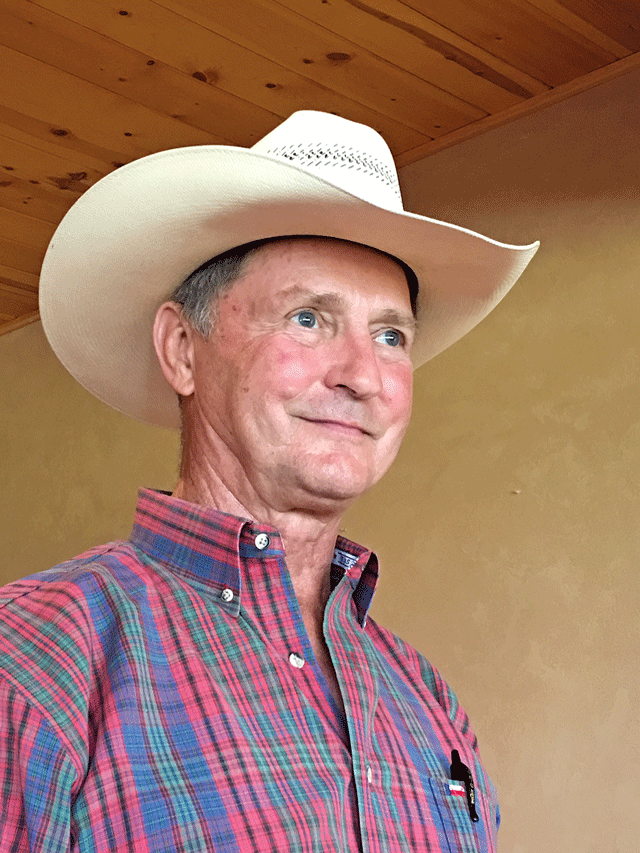
Jerome, present day – Rodeo News
In the middle of the decade of foreign events for Robinson and the WTR crew, they produced a 1992 bull riding in Scottsdale, Arizona for another promoter. Robinson remembers very little about that event other than the announcer being stricken with laryngitis and a woman rodeo association champion bull rider competing against the men, but a significant event took place in a room at the host hotel. A group of bull riders, several of who were the stars of the now defunct “Winston Tour,” acted on the basic premise of showcasing the premier contestant athletes, the best available livestock, and having those athletes compete multiple times in one performance. From that hotel meeting in Scottsdale, the delegation moved forward and soon afterward, twenty bull riders each putting up $1000, formed the “seed money” for a company that today is valued at between an estimated 150-200 million dollars… Professional Bull Riders,” the PBR!
The next two years were filled with WTR winter/fall productions and the small county fair circuit rodeos in eastern Colorado, Kansas and Oklahoma. Sometime in early 1994, a delegation from the PBR headed by Robinson’s former bull riding school student, standout Winston Tour competitor and PBR founding member, Cody Lambert summoned Robinson to a meeting where they (based on the Winston Tour and subsequent rodeo/bull riding production interaction) asked Robinson if he would be interested in being the production coordinator for their first “PBR World Finals” at the MGM Grand Garden in Las Vegas, Nevada. Robinson accepted the task and began a job that continues today. The first two “PBR World Finals” utilized almost all equipment and personnel supplied and hired by WTR. They were successful beyond expectations and doubled in prize money each of the first three years and with growth, the PBR purchased their own equipment and employed staff to take over many of Robinson’s initial responsibilities. Robinson has remained in a significant operational implementation capacity at every “PBF World Finals” for over twenty-five years. PBR also began partnering with promoters (Robinson being one of them) to produce their own events, many of which Robinson took on the handling of logistical operations and today refers to himself as the PBR’s “logistics coordinator”.
In 1999, while working on the sixth of the twenty-five PBR World Finals Robinson has worked on, he was bestowed the honor of being inducted into the PBR’s “Ring of Honor” for contributions to bull riding during his competition days and afterwards for work performed on behalf of the PBR. Earlier this year, Robinson was inducted into the “Bull Riding Hall of Fame” in Fort Worth, Texas and in August, Robinson will be inducted into the “PRCA Hall of Fame” as a “Notable Inductee” which is recognition of a competitive career along with contributions made while serving on the PRCA board of directors as bull riding director and a vice president. Serving a term on the National Finals Rodeo commission and serving on the PRCA research and development committee that recommended and facilitated the building of the PRCA headquarters in Colorado Springs and also the ProRodeo Hall of Fame and Museum.
As Robinson embarks on his seventh decade of his rodeo adventure, he admits he enjoys the job’s travel demands, claiming to be a gypsy, relishes the challenges of producing rodeos/bull ridings and looks forward to more years with the PBR. Robinson is up for at least one, if not half a dozen more tours on foreign soil to share the culture that he loves and that has been so rewarding to him.
